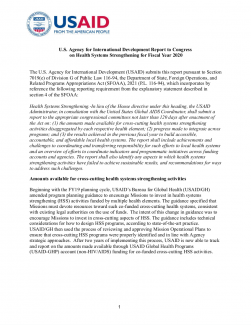Amounts available for cross-cutting health systems strengthening activities
Beginning with the FY19 planning cycle, USAID’s Bureau for Global Health (USAID/GH) amended program planning guidance to encourage Missions to invest in health systems strengthening (HSS) activities funded by multiple health elements. The guidance specified that Missions must devote resources toward such co-funded cross-cutting health systems, consistent with existing legal authorities on the use of funds. The intent of this change in guidance was to encourage Missions to invest in cross-cutting aspects of HSS. The guidance includes technical considerations for how to design HSS programs, according to state-of-the-art practice.
USAID/GH then used the process of reviewing and approving Mission Operational Plans to ensure that cross-cutting HSS programs were properly identified and in line with Agency strategic approaches. After two years of implementing this process, USAID is now able to track and report on the amounts made available through USAID Global Health Programs (USAID-GHP) account (non-HIV/AIDS) funding for co-funded cross-cutting HSS activities.
Typically, Missions use between 6 and 12 percent of their non-HIV/AIDS GHP budget to co-fund cross-cutting HSS, with some missions using more than 20 percent of their non-HIV/AIDS GHP budget to co-fund cross-cutting health systems, including in Laos, Timor Leste, and Indonesia. In absolute value, the Missions shown in the chart above have the largest cross-cutting HSS programs. In FY 2020, Nigeria programmed the largest amount toward cross-cutting HSS. Overall GHP funding in Nigeria decreased from FY 2019 to FY 2020, and when coupled with spending on COVID-19 and an increased focus on service delivery, this led to a reduction in resources for HSS activities. In Ghana, the decrease to cross-cutting HSS funding from FY 2019 to FY 2020 is reflective of an overall cut to the GHP budget for Ghana, but the percentage of funds going toward HSS still increased. In Mali and Kenya, the reduction in cross-cutting HSS is expected to be temporary as these Missions transition to new portfolios of awards for implementation. In Ethiopia, in addition to the Mission working on transitioning to a new portfolio of awards, the Mission’s funding was constrained by the U.S. Government pause on assistance during FY 2020.

